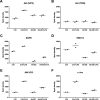Ectodomain shedding of the cell adhesion molecule Nectin-4 in ovarian cancer is mediated by ADAM10 and ADAM17
- PMID: 28232483
- PMCID: PMC5391762
- DOI: 10.1074/jbc.M116.746859
Ectodomain shedding of the cell adhesion molecule Nectin-4 in ovarian cancer is mediated by ADAM10 and ADAM17
Abstract
We previously showed that the cell adhesion molecule Nectin-4 is overexpressed in ovarian cancer tumors, and its cleaved extracellular domain can be detected in the serum of ovarian cancer patients. The ADAM (
Keywords: ADAM; ADAM10; ADAM17; Nectin-4; biomarker; cancer biology; cell migration; ovarian cancer.
© 2017 by The American Society for Biochemistry and Molecular Biology, Inc.
Conflict of interest statement
The authors declare that they have no conflicts of interest with the contents of this article
Figures







Similar articles
-
The xenoestrogens biphenol-A and nonylphenol differentially regulate metalloprotease-mediated shedding of EGFR ligands.J Cell Physiol. 2018 Mar;233(3):2247-2256. doi: 10.1002/jcp.26097. Epub 2017 Aug 25. J Cell Physiol. 2018. PMID: 28703301 Free PMC article.
-
ADAM10 and ADAM17-Novel Players in Retinoblastoma Carcinogenesis.Int J Mol Sci. 2022 Oct 20;23(20):12621. doi: 10.3390/ijms232012621. Int J Mol Sci. 2022. PMID: 36293469 Free PMC article.
-
Cleavage Site Localization Differentially Controls Interleukin-6 Receptor Proteolysis by ADAM10 and ADAM17.Sci Rep. 2016 May 6;6:25550. doi: 10.1038/srep25550. Sci Rep. 2016. PMID: 27151651 Free PMC article.
-
The Gut-Brain Axis in Autism Spectrum Disorder: A Focus on the Metalloproteases ADAM10 and ADAM17.Int J Mol Sci. 2020 Dec 24;22(1):118. doi: 10.3390/ijms22010118. Int J Mol Sci. 2020. PMID: 33374371 Free PMC article. Review.
-
Metalloproteinase inhibitors for the disintegrin-like metalloproteinases ADAM10 and ADAM17 that differentially block constitutive and phorbol ester-inducible shedding of cell surface molecules.Comb Chem High Throughput Screen. 2005 Mar;8(2):161-71. doi: 10.2174/1386207053258488. Comb Chem High Throughput Screen. 2005. PMID: 15777180 Review.
Cited by
-
Production and characterization of single-chain variable fragment antibodies targeting the breast cancer tumor marker nectin-4.Front Immunol. 2024 Jan 15;14:1292019. doi: 10.3389/fimmu.2023.1292019. eCollection 2023. Front Immunol. 2024. PMID: 38288120 Free PMC article.
-
ADAM10 and ADAM17 cleave PD-L1 to mediate PD-(L)1 inhibitor resistance.Oncoimmunology. 2020 Apr 14;9(1):1744980. doi: 10.1080/2162402X.2020.1744980. eCollection 2020. Oncoimmunology. 2020. PMID: 32363112 Free PMC article.
-
ADAM10: Possible functions in enamel development.Front Physiol. 2022 Nov 25;13:1032383. doi: 10.3389/fphys.2022.1032383. eCollection 2022. Front Physiol. 2022. PMID: 36505044 Free PMC article. Review.
-
Mechanistic Insights into the Successful Development of Combination Therapy of Enfortumab Vedotin and Pembrolizumab for the Treatment of Locally Advanced or Metastatic Urothelial Cancer.Cancers (Basel). 2024 Sep 4;16(17):3071. doi: 10.3390/cancers16173071. Cancers (Basel). 2024. PMID: 39272928 Free PMC article. Review.
-
A disintegrin and metalloproteinase domain 10 expression inhibition by the small molecules adenosine, cordycepin and N6, N6-dimethyladenosine and immune regulation in malignant cancers.Front Immunol. 2024 Aug 15;15:1434027. doi: 10.3389/fimmu.2024.1434027. eCollection 2024. Front Immunol. 2024. PMID: 39211038 Free PMC article.
References
-
- Siegel R. L., Miller K. D., and Jemal A. (2015) Cancer statistics, 2015. CA Cancer J. Clin. 65, 5–29 - PubMed
-
- Pradeep S., Kim S. W., Wu S. Y., Nishimura M., Chaluvally-Raghavan P., Miyake T., Pecot C. V., Kim S. J., Choi H. J., Bischoff F. Z., Mayer J. A., Huang L., Nick A. M., Hall C. S., Rodriguez-Aguayo C., et al. (2014) Hematogenous metastasis of ovarian cancer: rethinking mode of spread. Cancer Cell 26, 77–91 - PMC - PubMed
-
- Burleson K. M., Casey R. C., Skubitz K. M., Pambuccian S. E., Oegema T. R. Jr., and Skubitz A. P. (2004) Ovarian carcinoma ascites spheroids adhere to extracellular matrix components and mesothelial cell monolayers. Gynecol. Oncol. 93, 170–181 - PubMed
-
- Burleson K. M., Hansen L. K., and Skubitz A. P. (2004) Ovarian carcinoma spheroids disaggregate on type I collagen and invade live human mesothelial cell monolayers. Clin. Exp. Metastasis 21, 685–697 - PubMed
MeSH terms
Substances
Grants and funding
LinkOut - more resources
Full Text Sources
Other Literature Sources
Medical
Research Materials
Miscellaneous

